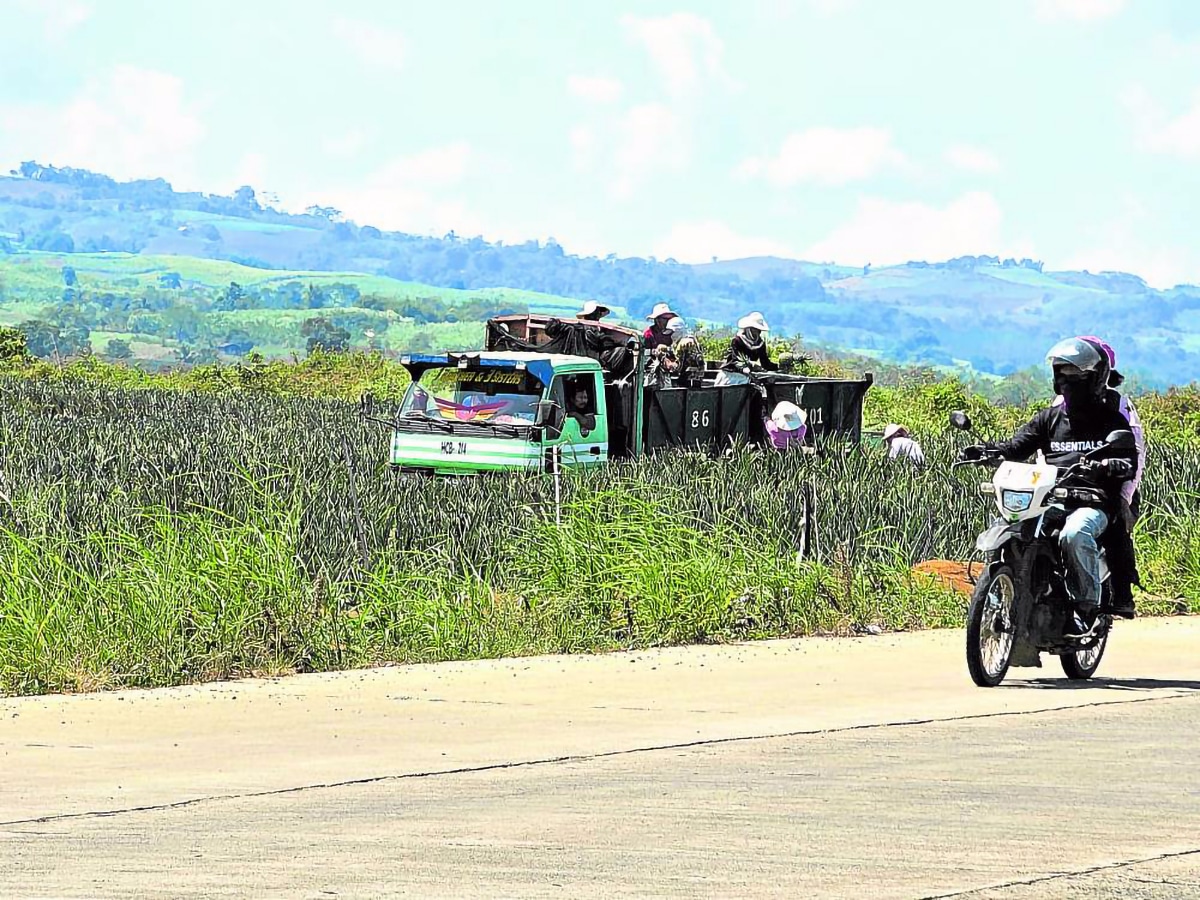Landowner resistance spoils agrarian reform

FARM YIELD Farmworkers harvest pineapple in a plantation that straddles Wao, Lanao del Sur, and Kalilangan, Bukidnon. Good profit from farming high-value crops in Bukidnon has driven many landowners to resist agrarian reform. —Ryan D. Rosauro
CAGAYAN DE ORO CITY, Philippines — Minda Nacino, a farmer in Valencia City, Bukidnon, is among the 147 agrarian reform beneficiaries (ARBs) waiting to occupy the land awarded to them by the government.
It has been some eight years of wait already and Nacino finds their Certificate of Land Ownership Award (Cloa) covering 57 hectares seemingly useless as they are not able to even see their land as its former landowner, the family of former Bukidnon Gov. Carlos Fortich, had held on to it.
Amid several attempts by the Department of Agrarian Reform (DAR) and government security forces, the ARBs had not yet been installed as security personnel prevented them from entering the estate.
READ: Marcos vows to complete agrarian reform by 2028
According to Norberto Paquingan, DAR assistant regional director, they do not simply install ARBs in the lands awarded to them without ensuring their safety.
Article continues after this advertisement“We need the cooperation of the local governments, military and police, in this regard,” Paquingan explained, adding that throughout the region, some 491 ARBs are still waiting to be installed.
Article continues after this advertisementBukidnon province is a prime agribusiness location in Mindanao where high-value crops, like banana and pineapple, are produced in large scale.
This vast opportunity to create wealth out of the land is driving landowner resistance to agrarian reform, preventing the DAR from fully completing its mission of distributing land to farmers in Northern Mindanao.
As of May 2024, DAR had already distributed 320,870 ha of land to 187,891 ARBs in the region, leaving a balance of only 4,738 ha, or a mere 3 percent of its target.
The remaining lands for distribution are “mostly problematic,” meaning there is “strong landowner resistance,” said DAR regional director Zoraida Macadindang.
About 69 percent or 3,251 ha of the balance is in Bukidnon, 24 percent (1,119 ha) in Lanao del Norte, 7 percent (335 ha) in Misamis Oriental. Misamis Occidental has a balance of 33 ha while land distribution had been completed on Camiguin Island.
Northern Mindanao is among the top performers in adjudication of agrarian cases throughout the country, with no backlogs in the last five years, said regional adjudicator Noel Carreon.
“It is just sad that strong landowner resistance is spoiling the implementation of our decisions on cases,” he said.
Clearing overlaps
In the Cordillera, three land-titling agencies are drafting guidelines to address overlaps between Cloa, Certificates of Ancestral Domain Title (CADT) and forest boundaries.
Samuel Solomero, DAR Cordillera director said a harmonization of land patents was crucial for sustaining the livelihoods as well as the economies of communities in the mountain region. To date, 104,000 ha of agrarian land have been awarded in the Cordillera, where the terrain requires many small farms and gardens to be carved out of mountainsides.
This number represents 99 percent of the government’s Cloa target for the Cordillera, Solomero said.
But the region is also Luzon’s watershed cradle with roughly 857,000 ha of forest cover or about half of the Cordillera’s 1.8 million ha territory that needs to be preserved. It is dominated by indigenous Filipino tribes, many of which own CADT or government-recognized ancestral domains, as well as individual ancestral lands covered by Certificates of Ancestral Land Title (CALT).
Ancestral domains are communally owned lands often as large as a town, which have existed “since time immemorial.” Ancestral lands are individual properties settled for centuries by indigenous peoples families.
Jane Toribio, the region’s chief agrarian reform program officer, said collective Cloas were released within the borders of Mount Pulag, Luzon’s highest peak and a significant biodiversity reserve.
These agrarian reform titles have been classified as “problematic” owing to jurisdictional conflicts with the Department of Environment and Natural Resources (DENR), the National Commission on Indigenous Peoples (NCIP) and the National Integrated Protected Areas System (Nipas) that controls all protected sites and parks, she said.
The NCIP and DAR are drafting a “joint guideline stipulating a common understanding as to how to address landholdings” covered by Cloa and by CADT and CALT, and resolve “delineation problems,” Solomero said.
In Eastern Visayas, Robert Anthony Yu, DAR regional director, said land distribution in the region had reached a completion rate of 97 percent since the program began in 1988.
Their records showed that the agency, over the next few years, needed to distribute 12,251.74 ha in Leyte; 4,260.93 ha in Northern Samar, 2,773.48 ha in Samar; 272.54 ha in Southern Leyte; and 150.61 ha in Eastern Samar. Yu said 504,303 ha of land had been distributed to 280,168 farmers in Eastern Visayas since the Comprehensive Agrarian Reform Program started in 1988. —report from Ryan Rosauro, Bobby Lagsa, Vincent Cabreza and Joey Gabieta